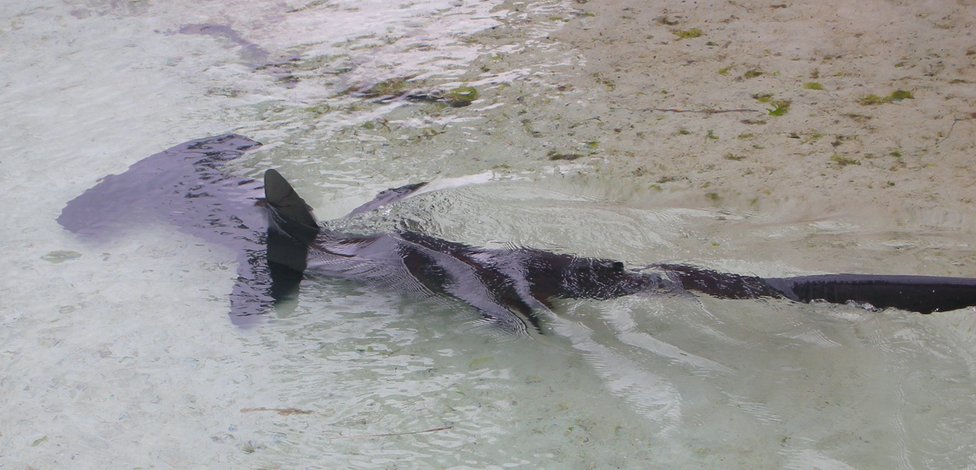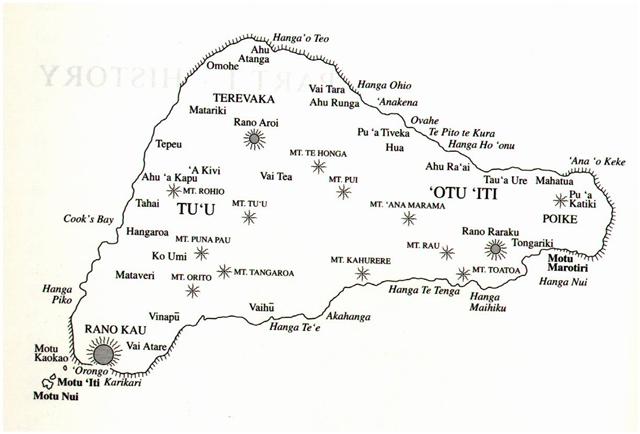53. On Easter
Island the name Tagaroa Uri for October probably
was meant
to indicate how this month was in a different kind of
season compared to that of
Tagaroa in the north. It was a season with fresh
greenery and not a season when the old leaves were falling
on their faces.
|
Uri
1. Dark; black-and-blue. 2.
Green; ki oti te toga, he-uri te ma˙ku o te
kaiga, te kumara, te taro, te tahi hoki me'e,
once winter is over, the grasses grow green,
and the sweet potatoes, and the taro, and the
other plants. Uriuri, black; very dark.
Vanaga.
Uriuri, black, brown,
gray, dark, green, blue, violet (hurihuri).
Hakahurihuri, dark, obscurity, to darken.
P Pau.: uriuri, black. Mgv.: uriuri,
black, very dark, color of the deep sea, any
vivid color. Mq.: uiui, black, brown.
Ta.: uri, black. Churchill.
Uli, s. Haw., the blue
sky; adj., blue, cerulean, green; uli-uli,
verdure; adj., green, dark-coloured, black.
Sam., Tong., Fak., uli; Tah., uri,
blue-black, any dark colour. Fornander. |
... What
happens after (or happened, or will happen sometime, for
this myth is written in the future tense), is told in
the V÷luspa, but it is also amplified in Snorri's
Gylfaginning (53), a tale of a strange encounter of
King Gylfi with the Aesir themselves, disguised as men,
who do not reveal their identity but are willing to
answer questions: 'What happens when the whole world has
burned up, the gods are dead, and all of mankind is
gone? You have said earlier, that each human being would
go on living in this or that world.' So it is, goes the
answer, there are several worlds for the good and the
bad. Then Gylfi asks: 'Shall any gods be alive, and
shall there be something of earth and heaven?' And the
answer is:
'The earth
rises up from the sea again, and is green and beautiful
and things grow without sowing. Vidar and Vali are
alive, for neither the sea nor the flames of Surt have
hurt them and they dwell on the Eddyfield, where once
stood Asgard. There come also the sons of Thor, Modi and
Magni, and bring along his hammer. There come also
Balder and Hoder from the other world. All sit down and
converse together. They rehearse their runes and talk of
events
of old days. Then they find in the grass the golden
tablets that the Aesir once played with.
Two
children of men will also be found safe from the great
flames of Surt. Their names, Lif and Lifthrasir, and
they feed on the morning dew and from this human pair
will come a great population which will fill the earth.
And strange to say, the sun, before being devoured by
Fenrir, will have borne a daughter, no less beautiful
and going the same ways as her mother.'
Then, all
at once, concludes Snorri's tale wryly, a thunderous
cracking was heard from all sides, and when the King
looked again, he found himself on the open plain and the
great hall had vanished ...
Tane had
pushed with his arms in the north and with his legs in
the south, all the way up to high summer. He had been
stretching tall - his dimensions were straight and vertical -
in contrast to the smooth undulating water of the sea
and the rough surface of the earth.
Tane had raised
the sky roof high, making an opening ('door') for spring light
to enter, and at midsummer (noon) he was exhausted and
sleepy and through his opening water entered and fell down as rain.
At the time of
Bharani (the birth place - the female organ of
reproduction) the Sun would have reached Antares at a
date which was around 41
precessional days earlier than the corresponding date at the time of
rongorongo. North of the equator the rebirth of Mother
Nature occurred before midsummer and south of the
equator the other (kÚ) rebirth of Mother Nature
also occurred before midsummer - but half a year later
in the year. Anciently Aldebaran marked spring equinox
north of the equator and Antares (the other Aries)
the spring equinox which was south of the equator.
| Ke
1. Other; different; different
being; hare kÚ, a different house;
e-kÚ-ro-ß... e-kÚ-ro-ß... there are some
who... and others who...; me'e kÚ,
something distinct, different: te puaka ina
oona kuhane; me'e kÚ te tagata, he hakari oona,
he kuhane, an animal has no soul; man is
different, he has a body, and a soul; matu'a
kÚ, the other relatives. 2. KÚ te kairua,
person who turns up for meals at other
people's homes. 3. Used in exclamations:
hahau kÚ! what a cool breeze!; hana kÚ!
how hot! takeo kÚ! how cold! Vanaga.
Other, distinct, different,
diverse, otherwise; koona ke, elsewhere;
tagata ke, some one else; mea ke,
contrary, distinct, otherwise; hakake,
feint, stratagem, to feign; hagake, to
act contrary. T Pau.: ke, different.
Mgv.: ke, another, other, else,
different, of partial comparative value. Mq.:
ke, Ú, to be different, changed, no
longer the same. Ta.: e, different,
strange, other. Churchill. |
| E, adv.
and ppr. Haw., from, away, off, by,
through, means of; also, adverbially, something
other, something strange, new; adj. contrary,
opposed, adverse, other, foreign. Sam.: e,
ppr. by, of; ese, other different,
strange. Ta., e, ppr. by, through,
from; adv. away, off; adj.
different, strange, distant; ee, strange.
N. Zeal., ke, strange, different. Malg.,
eze, of, by.
Greek,
έκ, έξ, from out of, from, by, of;
έκει, in that place, opp. to
ένθαδε,
in some other place than that of the speaker,
thither; έκας,
afar off. Lat., e, ex, out of,
from. Liddell and Scott (Gr.-Engl. Dict., s. v.)
say: 'The root of έτ-ερος is said to be
the same as Sanskr. ant-aras, Goth.
auth-ar, Germ. and-er, Lat. alt-er,
aut, French aut-rui, our eith-er,
oth-er, itara = alius, also
in Sanskrit.' Whatever the root of ant-aras,
auth-ar, alter, it seems to me
that έκας
shows nearer
kindred to the Polynesian e, ke,
ee, ese, eze, than to forms
so developed as ant-ar, ant-ara,
&c. (Fornander) |
When Aries took
over after Taurus - i.e. when western civilization had to be rebuilt
again after the devastation caused by the Santorini explosion around 1650 BC -
Aldebaran was no longer rising with the Sun at the
equinox, and the distance from Bharani (*41) to Aldebaran
(*68) was 27 days. Likewise did Antares no longer
rise with the Sun at the
southern equinox but in day 265 + 27
= 292 (= 4 * 73 = 365 - 73).
However, by using
the faulty Gregorian calendar - not corrected for the 4
extra precessional days before the Council of Nicaea in
325 AD - the
date Tagaroa Uri 15 had to be 4 days earlier in
the C text than
at day 292. Counted from 0h this became 292 - 4 = 288 (= 2
* 144 = 12 * 24 = 8 * 36 = 4 * 72 = 360 - 72), which was in full agreement with the date
Gregory XIII had decided to use for launching his 'crooked canoe'
(calendar):
|
SEPTEMBER 20 |
21
(*184) |
EQUINOX |
23 |
24 |
25 (268) |
 |
 |
 |
 |
 |
 |
|
Ga7-14 |
Ga7-15 (184) |
Ga7-16 |
Ga7-17 |
Ga7-18 |
Ga7-19 |
| |
|
ANTARES |
|
|
|
|
November 23 |
24 |
25 (329 = 325 + 4) |
26
(*250) |
27 |
28 |
|
░November 19 |
20 |
21 (325) |
22
(*246) |
23 |
24 |
|
'October 27 (300) |
28 |
29
(*222) |
30 |
31
(= 17 + 14) |
'November 1 |
|
"October 13 |
14 |
Tagaroa Uri
15 |
16
(*209) |
17
(290 = 331 - 41) |
18 |
... The
canoes of Ava Rei Pua and of Hotu were
seen near the (off-shore) islets. On the fifteenth day
of the month of October (tangaroa uri) the
canoe of Hotu and the canoe of Ava Rei Pua
landed. On the fifteenth day of the month of October (tangaroa
uri), Nonoma left the house during the
night to urinate outside. At this point Ira
called out to Nonoma, 'Look at the canoe!'
Nonoma ran, he quickly went to Te Hikinga Heru
(a ravine in the side of the crater Rano Kau) and
looked around. There he saw the double canoe way out
near the (offshore) islets, and the two (hulls of the
canoe) were lashed together. He ran and returned to the
front of the house. He arrived and called into the
house: 'Hey you! This canoe has arrived during the night
without our noticing it!' Ira asked Nonoma,
'Where is the canoe, which you say is lying out there
(in the water)?' Nonoma's voice came back: 'It is
out there (in the water) close to the (offshore) islets!
There it lies, and the two (hulls) are lashed together.'
The four of them (corrected for 'the six of them') went
out and picked up leaves (on branches) to give signals.
They picked them up, went and arrived at Te Hikinga
and saw the canoe. Raparenga got up, picked
up the leaves, took them in his hands, and waved, waved,
waved, waved
...
The
Explorers returned home 10 days later, and
this, we can read in the C text,
corresponded to the time of tagata rogo:
|
no glyph |
 |
 |
 |
 |
 |
 |
|
Ca1-1 |
Ca1-2 |
Ca1-3 |
Ca1-4 |
Ca1-5 |
Ca1-6 |
|
koia |
ki
te hoea |
ki
te henua |
te rima te hau tea |
haga i te mea ke |
ki
te henua - tagata honui |
|
CLOSE TO THE SUN: |
|
║Sept 16 |
17 |
18 |
19 |
20 |
21
(264)
|
EQUINOX |
|
ALCHITA
= α Corvi,
MINKAR (Beak)
= ε Corvi |
P┴LIDA (Pale)
= δ Crucis |
GIENAH (Wing)
= γ Corvi, ζ Crucis |
CHANG SHA (Long Sand-bank)
= ζ Corvi |
INTROMETIDA
= ε Crucis,
ACRUX
= α Crucis |
ALGORAB
= δ Corvi,
GACRUX
= γ Crucis |
AVIS
SATYRA
= η Corvi,
KRAZ
= β Corvi |
|
Sept 20
'Aug 24 |
(264 = 237 + 27)
(237 =
242 - 5) |
EQUINOX
26 |
23 (266)
27 |
JULY
22 (π)
28 (240) |
25 (*5 +
183)
29 |
(59 + 183 + 27)
30 (242 = 11 * 22) |
|
"Aug 10 |
11 |
12 |
13 |
14 |
15 (227) |
16 |
|
CLOSE TO THE FULL MOON: |
|
║March 16 |
17 |
18 |
19 (78) |
20 |
21
(0h) |
22 |
|
SIRRAH (Navel of the Horse) |
ALGENIB PEGASI |
|
|
|
ANKAA |
|
|
March 21 (0h)
'Febr 22 |
22
TERMINALIA |
23
24 |
24 (83)
25 |
JULIAN EQUINOX
26 |
26
27 |
27
28 (59) |
|
"Febr 8 |
9 |
10 |
11 |
12 |
13 |
14 (45) |
|
57 |
 |
 |
 |
 |
|
Ca3-13 (64) |
Ca3-14 |
Ca3-15 |
Ca3-16 |
|
kiore i te henua |
tapamea - tagata hoi
hatu |
ki te ariki |
kiore i te henua |
|
CLOSE TO THE SUN: |
|
November 23 |
24 |
25 (329) |
26 |
|
"October 13 (286) |
14 |
Tagaroa Uri 15 |
16 |
| |
|
ANTARES |
|
|
CLOSE TO THE FULL MOON: |
|
May 24 |
25 (145) |
26 |
27 |
|
"April 13 |
14 (104) |
15 |
16 |
|
HYADUM II |
AIN |
|
|
 |
 |
 |
 |
|
Ca3-17 |
Ca3-18 |
Ca3-19 |
Ca3-20 (71) |
|
tapamea - tagata rima
iri |
te henua te hokohuki |
te
kava |
te kiore i te henua |
|
CLOSE TO THE SUN: |
|
November 27 |
28 |
29 (333) |
30 |
|
"October 17 |
18 |
19 (292) |
20 |
|
CLOSE TO THE FULL MOON: |
|
May 28 (148) |
29 |
30 |
31 |
|
"April 17 (107) |
18 |
19 |
20 (*20) |
|
ALDEBARAN |
|
|
|
|
time of the Goat |
 |
 |
 |
 |
 |
|
Ca3-21 |
Ca3-22 (73) |
Ca3-23 |
Ca3-24 |
Ca3-25 |
|
tagata tuu rima ki
ruga |
te maitaki |
te henua |
Rei hata ia |
tagata rogo |
|
CLOSE TO THE SUN: |
|
"October 21 |
22 (295) |
23 (*216) |
24 |
Tagaroa Uri 25 |
|
CLOSE TO THE FULL MOON: |
|
MARCH
29 (88) |
HASSALEH (*73) |
HAEDUS I |
HAEDUS II |
CURSA |
|
June 1 (152) |
2 |
3 |
4 |
5 |
|
░May 28 (148) |
29 |
30 |
31 |
░June 1 (152) |
|
'May 5 (125) |
6 |
7 |
8 |
9 |
|
"April 21 (111) |
22 |
23 |
24 |
Vaitu Nui 25 (115) |
...
The Explorers left Easter Island for their
journey home 10 days after Hotu had
arrived. I.e. they had stayed on Easter Island
from "June 1 (152) to "October 25 (298) = 146
days. Counting from their departure from Hiva
to their departure from Easter Island gives as a
result the significant number 183 (= 366 / 2 =
298 - 115)
...
|
Dates according to Manuscript E -
Explorers: |
|
Departure from Hiva |
Sea voyage |
Arrival |
|
Vaitu Nui 25 (115) |
152 - 115 = 37 days |
Maro 1 (152) |
|
"April 25 (115) |
(*72 - *35) - (41 - 4) = 0 |
░June 1 (152) |
|
CURSA (*76) |
CURSA (*76) |
|
Dates according to Manuscript E -
Hotu A Matua: |
|
Departure from Hiva |
Sea voyage |
Arrival |
|
Hora Nui 2 (245) |
288 - 245 = 43 days |
Tangaroa Uri 15 (288) |
|
░Sept 2 (245 = 152 + 93) |
*249 - *169 = 80 |
Oct 15 (*249 = *76 + 173) |
|
ZOSMA, COXA (*169) |
ANTARES (*249) |


North of the equator the Scorpion was characterized by
his long curved tail ending in a sharp point,
but the Polynesians could here see a ferocious Shark with a long snout.
|
 |
|
mago |
| Mago
Spotted dogfish, small shark.
Vanaga. Mogo,
shark. P Pau.: mago, id. Mgv. mago,
id. Mq. mano, mako, mono, moko id. T.
maˇ, id. In addition to this list the word
is found as mago in Samoa, Maori, Niuē,
and in Viti as mego.
It is only in Rapanui and the Marquesas that we
encounter the variant mogo.
Churchill. |
|
...
The handsome shark
Fa'a-rava-i-te-ra'i, Sky-shade, is there in
his pool and close by is Pirae-tea, White
Sea-swallow (Deneb in Cygnus) in the
Living-waters of Tane ...
(Makemson) |
|
... Here, in a very condensed
form, is a typical Fijian myth of the origin of
the current ruling clan (mataqali): A
handsome, fair-skinned stranger, victim of an
accident at sea, is befriended by a shark who
carries him ashore on the south coast of Viti
Levu. The stranger wanders into the interior
where he is taken in by a local chieftain, whose
daughter he eventually marries. From this union
springs the line of Noikoro ruling
chiefs, the narrator of the story being the
tenth descendant on that line. He and his
clansmen are called 'The Sharks' (Na Qio)
... It is all as in the Hawaiian proverb: 'A
chief is a shark that travels on land'...
(Islands of History) |
|
... Further to
the east, there is Tama, whose addition
'an evil fish with a long nose' is explained by
Juan Tepano to mean 'a shark' (he niuhi
ME:58) [niuhi tapaka'i = hammerhead shark
according to Vanaga] and may be connected with
the youngest son of Hotu Matua (TP:54)
...
... The first and
third sons rule over important points along the
northern and southern shores. Their domains can
be said to represent the noon and the midnight
sides of the island and, as such, are in
contrast with each other. On the other hand, the
words of the king to his second and fourth sons
refer to contrasting types of behavior. It is
Miru's task to watch over his people, while
Hotu Iti is compared to a dangerous
shark. My informants explained niuhi tapaka'i
as como diablo and called it an
attribute for an hombre valiente. Englert
was not familiar with the word, but I suspect
that it is related to TON. tapakaki 'to
run swiftly', and I suggest the translation
'swift (?) shark', which seems an appropriate
metaphor for a brave man ... (Barthel 2)
 |
|


















